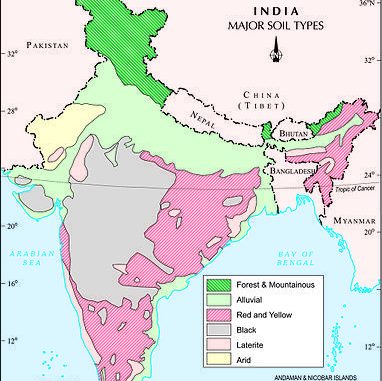
The upper layer of earth in which plants grow, a black or dark brown material typically consisting of a mixture of organic matter, minerals, gases, liquids and organisms.
Types of Soil-
- Alluvial Soil
- Red Soil
- Black Soil
- Laterite Soil
- Desert/ Arid Soil
- Mountain Soil
Alluvial Soil– These are formed by the deposition of sediments by rivers. They are rich in humus and very fertile. They are found in Great Northern plain, lower valleys of Narmada and Tapti and Northern Gujarat.
Red Soil– These are derived from weathering of ancient metamorphic rocks of Deccan Plateau. Its redness is due to iron composition.
Black Soil– These soils are made up of volcanic rocks and lava-flow. It consists of Lime. Iron, Magnesium and also Potash but lacks in Phosphorus, Nitrogen and Organic matter.
Laterite Soil– These soils are formed due to intense leaching and are well developed on the summits of hills and uplands. These soils are rich in aluminum and iron oxides. Laterite soils do not retain moisture.
Desert/Arid Soil– These soils are sandy and have low clay content. Due to high evaporation in arid regions, the soils become deficient of humus and moisture. The color of this soil ranges from red to brown and light brown.
Mountain Soil– These soils are formed as a result of the accumulation of organic matter derived from forest growth.
| Soil | Place | Crops |
|---|---|---|
| Alluvial | Gujarat,Punjab, Haryana, UP, Bihar, Jharkhand | Wheat, Rice, Sugarcane Cotton, Jute |
| Red | Orissa, Chattisgarh and sothern parts of the middle Ganga plain | Wheat, Rice, cotton, Sugarcane and Pulses |
| Blank | Maharashtra, Madhya Pradesh, Gujarat, Andhra Pradesh, Tamil Nadu, Valleys of Krishna and Godavari | Cotton, Sugarcane, Jowar, Tobacco, Wheat, Rice |
| Laterite | Karnataka, Kerala, Tamil Nadu, Madhya Pradesh, Assam and Orissa hills | Cashewnuts, Tea, Coffee, Rubber |
| Desert/Arid | Western Rajastan, North Gujarat and southern Punjab | Barley, Rape, Cotton, Millets, Maize and Pulses |
Leave a Reply